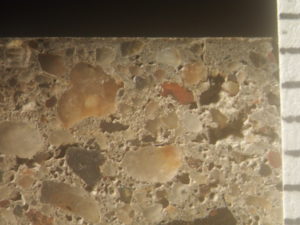When finishing air-entrained concrete, less is more. Hard-troweled surfaces and air-entrained concrete don’t mix. If you need to entrain air—that is, if the concrete will experience cycles of freezing and thawing while wet—you should do as little finishing as possible. But why is that?
An air-entraining agent should not be specified or used for concrete to be given a smooth, dense, hard-troweled finish because blistering or delamination may occur. These troublesome finishing problems can develop any time the total air content is in excess of 3%.— ACI 302.1R
Hard troweling

There are times when concrete needs a hard, dense surface. For example, a warehouse floor will experience hard use and abrasion from forklifts, so the harder the surface the better. Similarly, industrial floors may also need hard surfaces. To accomplish that, we need the concrete to be strong, but not prone to shrinkage. Then we harden the surface by hard troweling.
The solids in concrete—cementitious materials and aggregates—are denser than water. Once the concrete is in place, the solids settle and water begins to appear at the surface. We call this “bleeding.” Concrete finishers must wait until the bleeding stops before they start working. The reason is that hard troweling densifies the surface, trapping water below it.
Under normal circumstances, it’s easy to tell when concrete is bleeding—there’s a wet sheen on the surface. But when the surface dries faster than the bleed water appears, it’s harder to tell. On a hot, dry, windy day, the surface dries quickly. That’s why it needs protection from drying.
Air entrainment slows the bleeding, and that can cause confusion. Is the surface dry because the bleeding has stopped or because it’s too slow to keep up with the drying? It looks pretty much the same to the finisher.
Under the microscope, the dense, hard-troweled surface looks darker than the rest of the concrete. You can also see a void a few millimeters below the surface where bleed water was trapped. That void may eventually cause delamination.
Finishing air-entrained concrete
Sometimes there’s good reason to entrain air in a concrete slab. For example, you might use lightweight concrete for an elevated slab. Lightweight concrete often contains entrained air to reduce the density. However, in that case you’ll need to decide whether you can accept a rough finish. That may be okay if you’re going to use a floor covering. But if the concrete surface is to remain exposed, forgo the air and design for slightly heavier concrete. That way you can get the finish you want.
A few years ago, a contractor had to entrain air in a concrete slab because of the construction sequence. In compliance with the owner’s schedule, he placed the slab in the fall and then built the enclosure the following spring. To survive the winter’s cycles of freezing and thawing, the concrete needed air entrainment. Unfortunately, air entrainment wasn’t compatible with the hard-troweled finish the owner wanted, and no one was happy with the result.
When constructing a warehouse, industrial facility, big-box store, or anything else with a concrete floor that will see hard use in service, the right construction sequence helps. Completing the enclosure before placing the floor will protect it from freezing, wind, rain, and direct sun. Then you don’t need to entrain air. In fact, it’s a good idea to measure the air content of the fresh concrete. If it’s above 3%, it has entrained air and should be rejected.
But for an exterior slab in a freezing climate, you need to design the concrete for that exposure. That includes air entrainment, which means you need to minimize the effort you put into finishing the concrete. Follow good practices for hot-weather or cold-weather concreting if conditions warrant. Note that you’ll have less time to place and finish the concrete in hot weather. And don’t place the concrete too late in the year, as it needs time to cure and then dry out before it freezes.
